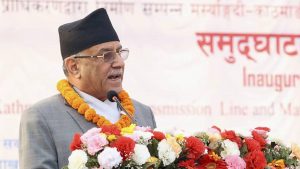
NRB Takes Measures to Address Excessive Liquidity Amidst Declining Loan Demand

Nepal’s banks and financial institutions (BFIs) find themselves grappling with a surplus of liquidity, as the demand for loans experiences an unexpected dip. The Nepal Rastra Bank (NRB) has taken proactive measures to counterbalance this excess liquidity, absorbing a substantial Rs 180 billion from the banking system through various monetary instruments since mid-December.
The central bank’s actions extend beyond liquidity absorption, as it strives to maintain inter-bank lending rates within prescribed limits. Despite previous assertions that inter-bank lending rates would not fall below three percent, recent trends have seen these rates dip below the designated threshold. NRB Spokesperson Dr. Gunakar Bhatta clarified that after the rates fell below the prescribed limit, liquidity absorption through deposit auctions successfully pushed interbank lending rates above the three percent mark on January 3 and 4.
The heightened liquidity can be attributed, in part, to a decrease in imports and a lackluster demand for credit from various sectors, according to Dr. Bhatta. Commercial banks, development banks, and financial institutions together boast a credit extension capacity of Rs 433 billion. However, despite an annual deposit growth of Rs 500 billion, their lending capacity has not experienced a corresponding increase.
Total deposits across BFIs have surged to an impressive Rs 6.06 trillion, with Class ‘A’ banks alone holding Rs 5.37 trillion. The investment landscape reflects a similar pattern, with BFIs investing around Rs 5.02 trillion. Class ‘A’ commercial banks account for a significant Rs 4.44 trillion of this total, while development banks and financial institutions have extended credit amounting to an additional Rs 582 billion.
Bankers acknowledge that working capital policies, including restrictions on extending new loans in the final month of the quarter, contribute to the accumulation of loanable funds. Nepal Bankers Association (NBA) President Sunil KC explained that banks prioritize the recovery of old loans over new investments in the last month of the quarter, further expanding the size of available funds.
Private sector leaders, such as Chandra Prasad Dhakal, president of the Federation of Nepalese Chambers of Commerce and Industry (FNCCI), shed light on the challenges faced by businesses. Dhakal emphasized a 20-30 percent decline in both production and sales, making loan servicing a daunting task. Uncertainties about policy stability have also led businesses to hesitate in seeking new credit.
However, Dhakal expressed optimism about a positive upturn in the near future. He highlighted the potential restoration of confidence among both the private sector and consumers with the gradual fall in interest rates. Recent policy decisions by the central bank, coupled with the government’s commitment to settling outstanding dues and expediting capital spending, provide a glimmer of hope.
A survey conducted by the Confederation of Nepalese Industries (CNI) further underscores the overall decline in demand, citing rising industrial raw material prices despite a fall in their import. As Nepal navigates this financial landscape, stakeholders eagerly await signs of economic recovery amidst evolving policy dynamics.














Comments